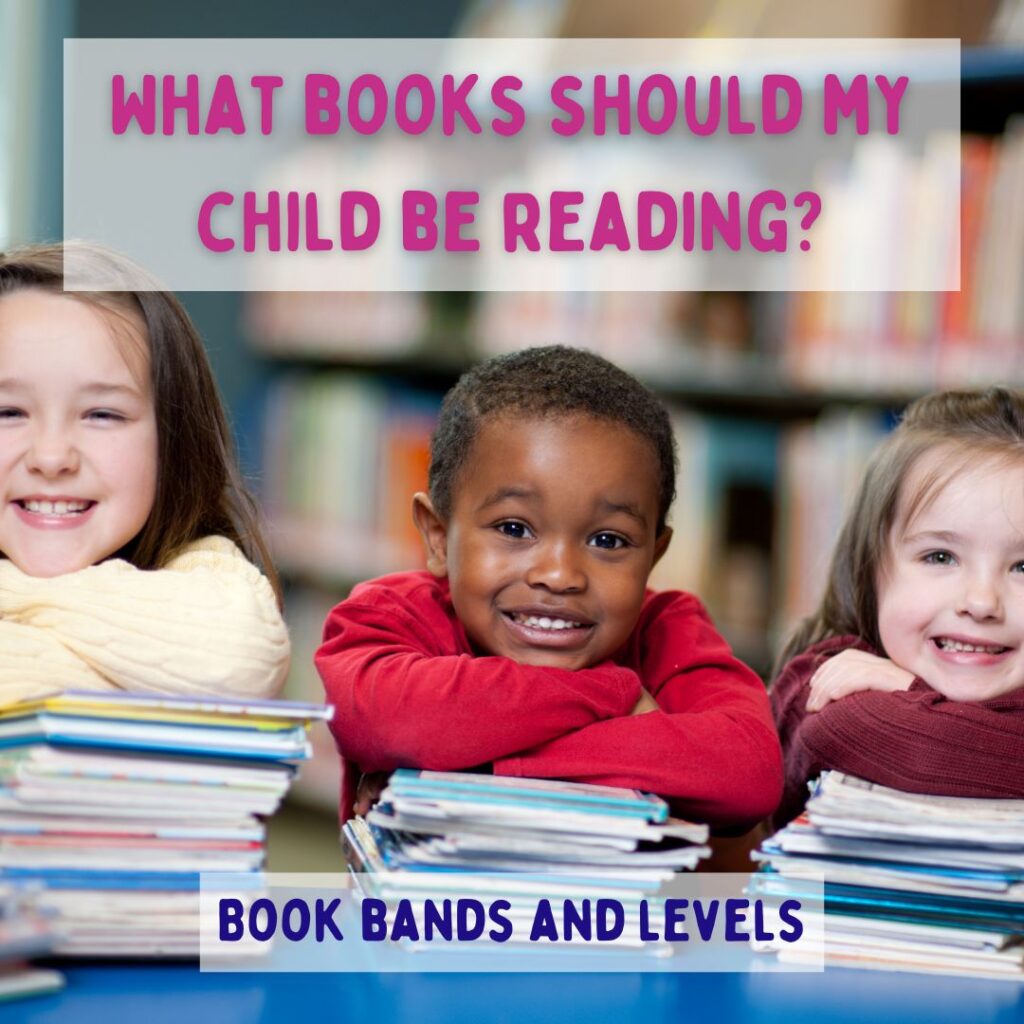What books should my child be reading?
Book levels and bands

I want to preface this blog post by saying that not all schools follow the same way of marking their book levels, and not all book schemes are kind enough to match the colour levels (Though thankfully, Oxford Reading Tree does!). I will do my best to cover the different levels of book bands, but please take it with a pinch of salt!
In school, children are often told they are on a certain ‘colour’ of book. This is meant to make it easier for everyone to know where the child is in their reading journey and help parents support with reading at home. But book bands are very rarely (if ever) explained.
I’m hoping to make it a bit clearer for you, and also give you some tips on how you can choose books for your little one, even if they aren’t colour coded.
Book band colours
Most ‘early reading books’ are marked with a colour, corresponding to how hard they are to read. Below, I will give a quick overview of what happens at each level.
With reception books, it’s good to focus on spaces between words, punctuation, sounding out CVC words (consonant-vowel-consonant) and spotting common high frequency and tricky words (like – the, I, etc.)
Quite repetitive, very short. Usually read with an adult. These books are used to get children recognising words and the spaces between them. Children are not expected to read these to themselves or with support. They may start to remember some very common words though!
Very similar to pink books. Again, these are designed to be read with an adult with very little reading from the child. Focus on comprehension questions to develop understanding and recognising some tricky words.
I have known many Year 1 children who start on these books.
Children are able to read a word or two themselves by blending, and should be recognising a few high frequency words. There are slightly more words per page, though the sentences are likely still repetitive.
With year 1 books, children begin to read words without blending and more fluency. Some children may whizz away and be able to read longer words without hesitating, while others will be able to read shorter words by sight and sound out longer words. It’s a good idea to work on ‘chunking’ longer words to help children remember different parts of them.
Children often reach Blue books in the first term of Year 1. There are usually more words that can be blended (including digraphs) and more varied sentences. Children are more likely to be able to read a whole sentence by sounding out and recognising tricky words. They don’t need to be reading fluently though, and will still be sounding out most words! Books begin to have CVCC or CCVC words in them.
Children are able to recognise or blend most of the sounds in words. They are able to recognise punctuation, meaning they might pause at full stops or commas. This is when most children start to say some common words without blending them out loud. The books get a bit longer and children work on their reading stamina by trying to read longer and longer sections! There are usually more consonants blends in words.
Again, these books get harder. Children might be reading multi-syllable words and should be recognising a broader range of tricky words (phase 5 tricky words for example). Again, children blend words more rarely and their reading becomes more fluent. Books normally have between 4 and 5 sentences to a page.
At this point, the Year groups become a little mixed up! Some children will be happily on Purple books in Year 1 and some will be happily on Orange books in Year 2. As long as your little one is enjoying reading and is moving towards reading without sounding out, they’re doing great!
At this point, children should start to be able to read with expression and not be using the picture to work out what will happen next. They will be almost fluent readers, and will be tackling longer books with more sentences and smaller pictures.
In real terms, at this point a child might well be considered a ‘free reader’ in that they can feasibly pick up any book and read it. They might begin reading in their head and will be comprehending what they read much more quickly. This is where we encourage as much comprehension as we can, particularly with inferences! For more information on this, check out my blog on comprehension!
These are chunkier books, though still with large pictures. They tend to have around 10 sentences per page and your child should be able to read silently, sounding out only new words and quickly assimilating them into their vocabulary.
The beginning of chapter books! While these chapters may be short, children are able to remember a lot of what they have read and explain it to someone else. They can also answer questions about the text as a whole.
When your child gets to lime green books, it’s a fair bet to say that they can read most books fluently in their heads. They don’t tire easily when reading and understand almost everything they read.
As you can see, there is a bit of crossover when it comes to different levelled books and this is what makes it very hard to work out what level your little one should be on. Some books in a band will be harder than others and you may even find that they are harder than a book in the level above. I’m general, a child moves on when they can read 80% of the books in the band at the required level.
As I said, the levels at which children start to read each book band should be taken with a pinch of salt. Every class of year 1 children I have ever taught has had children on Yellow books and children on Purple books too! Every child learns at their own pace!
To recap –
- pink-red – mostly read by the adult with a few blending words
- Yellow – mostly sounded out by your child with phase 2 words
- Blue – mostly sounded out by your child with digraphs/trigraphs
- Green/orange – sounded out with some words not blended. Consonant blends
- Turquoise/purple – reading without sounding out most words
- Gold/white – reading in your head
- Lime green – chapter books and increased reading stamina.
When should your child move up a book band?
Again, this is slightly difficult to answer as each phonics scheme has slightly different criteria. Some say your child should be able to read every word in a book confidently before moving on, and others say it should be only half the words. Equally, this can be difficult to work out in the lower levels, as some of the books must be read by parents in order to be understood.
I would suggest that your child moves up a level when they can recognise roughly 70% of words in most of the books they are given and can answer comprehension questions relevant to their age level (again, if you want help with this, check out my comprehension blog).
I do just want to mention that there can be a difference in what your little one reads confidently to you and what they read confidently in class. Reading in front of others can be worrying and may mean children don’t read as surely as they would at home. If this is what your little one is struggling with, it’s better to keep them on a lower book band until their fluency is higher, so boosting their confidence around others, rather than pushing them to read more complex texts and adding more stress in class.
If you are looking for an un-levelled book in the library, you want to be looking for;
- Books with tricky words within your child’s phonics phase
- Of the other words, they should be 80% words that your child can decode (words that can be sounded out)
- Sentences per page similar to what your child is used to
If you’ve found this helpful, please check out my other blogs on this website, or join my Facebook group – Reading in Reception – where I offer more advice and support!
If you want to support your child further and get more individualised support for both you and your child, check out my course – Curious to Confident – where you can learn all about teaching the pillars of reading, become confident that you know where your child is in their reading journey, how to ensure you’re getting the most out of reading with your child, and how to fit learning into your day with no extra preparation needed from you. Check it out!
